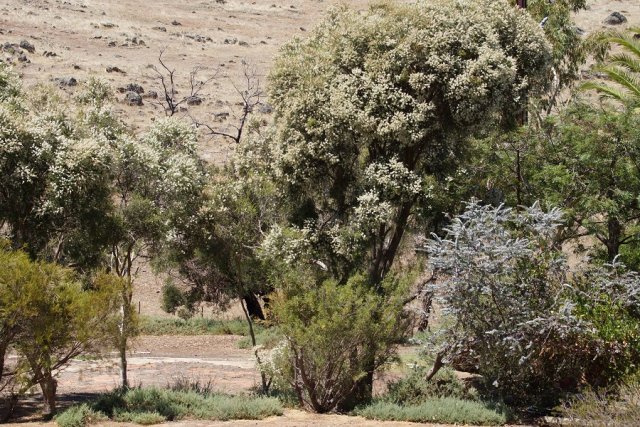The Dryland Tea Trees on our place are now between 20 & 27 years old. Ever since they first flowered in their early years I noticed insects, wasps (I think) & feral European Honey Bees feeding on the flowers but until about 2 years ago I'd never seen a nectar-feeding bird feeding on the flowers. I saw a New Holland Honeyeater feeding on the flowers in 2014 & another last summer, if I remember correctly. This summer I've seen three feeding occurrences including last Sunday when I saw a small flock of at least 3 New Holland Honeyeaters feeding.
I'm wondering if Melaleuca lanceolata, a very slow growing species, takes some years to mature enough to produce sufficient nectar to attract Honeyeaters, at least. Is this a feature of slow growing, bird attracting Australian plants?











That's some gorgeous looking plants you have there, Woko. I know some of South Australian plants are very long lived and will not produce flowers until they are 7 years old or more. Melaleucas are reknown for doing this. A neighbour had a Melaleuca in her garden that was like that. I think it was 8 years old when it started flowering, here in Tenterfield, NSW.
When it comes to plants producing nectar for birds - if that is the intention anyway - I think there needs to be a need for it in the first place. I know plants react to their environment and attract pollinators. They have to so they can reproduce seed and have offspring. So bees and other insects would fit this function in the early years.
I've always asked myself what the role of nectar is for a plant to produce it? Is it to keep the pollinators coming back, like a reward for pollinating it's flowers? Perhaps it is. But as plants react to their environment, your particular plant may be lacking pollinating birds in the area. I reckon those New Holland Honeyeaters just happened to stumble across the melaleuca by chance. That does happen, I'm sure of it. Perhaps they investigated what the bees were doing and tried a taste test on the trees' flowers. The birds obviously liked the nectar and came back.
Any plant that is rich in nectar will attract the most honeyeaters and even insect eaters (birds) eventually.
But the point I'm trying to make is there have to birds feeding off the plants, initially, before it starts producing higher quality and richer nectar for birds to feed from if the plant is ever going to attract the birds back time and time again. Which brings me to my question again: What is the purpose of nectar feeding birds to a plant? Do New Holland Honeyeaters eat insects as well? I mean, the tree already has pollinators (bees and wasps?) so there is no real need for further pollinators unless the trees are trying to achieve something.
I'm at Tenterfield, NSW. (Formerly known as "Hyperbirds".)
I know from beekeepers that Australian plants are not particularly reliable for producing nectar. Melaleuca are in the same myrtaceae family as Eucalypts so maybe they are similar for only producing nectar some years. There may be insects that eat all the nectar before the birds can get it, maybe the insects are not around lately - just a possibility. Sometimes trees such as Yellow Box will flower but not produce nectar some years.
interesting
that may well explain why some local eucalypt blooming events are seemingly ignored by honeyeaters and lorikeets
Yes, Shirley, I think many of the Melaleuca lanceolata I've planted have been three or four years old before they flower. They're certainly stunning when in flower & the larger they become the more stunning they are.
There are nearly always plenty of New Holland Honeyeaters around to dine out on the Melaleuca & other flowers. Their numbers were way down for a few weeks last spring but are now back with a vengance now that the South Australian Blue Gums Eucalyptus leucoxylon are coming into abundant flower. This species hardly flowered at all in 2015 but is really making up for it this year.
I think it's a reasonable hypothesis that birds are attracted by nectar & then play their role as pollinators. As they say in the corporate boardrooms it's a win - win for the birds & the trees.